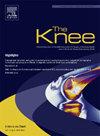胫骨结节截骨术后并发症增加的预测因素。
IF 1.6
4区 医学
Q3 ORTHOPEDICS
引用次数: 0
摘要
目的:本研究的目的是确定三级医疗机构TTO术后轻微和主要并发症的发生率,并确定与主要并发症发生相关的预测因素。研究设计:回顾性病例系列。iv级:方法:回顾性分析2011年至2023年接受TTO的患者。没有至少30天随访和翻修的患者被排除在外。“主要”并发症包括术中骨折、术后骨折、固定物丢失、延迟愈合、不愈合、肺栓塞(PE)、髌骨肌腱断裂、深部感染、需要取出的硬体疼痛、需要再手术的关节纤维化、复发性髌骨不稳定、因其他指征再手术、再入院和翻修。轻微并发症包括浅表感染、深静脉血栓形成、伤口裂开和术后神经失用。分类变量采用卡方检验,连续变量采用t检验。结果:436例患者的476例tto被纳入最终队列,平均随访时间为1.9年(1个月-10年)。患者中女性占68.5%,平均年龄28.3岁(13-57岁)。总并发症发生率为27.5%。严重并发症占23.7%,轻微并发症占8.4%。在指数手术后平均14个月,16.6%的TTOs需要再次手术。最常见的并发症是需要取出硬体的疼痛(6.5%),浅表感染(5.7%)和需要返回手术室的关节纤维化(5.0%)。通过回归分析,既往同侧手术被确定为主要并发症的重要独立预测因子。用带头螺钉拆卸硬件更为常见。需要再次手术的关节纤维化在同时进行软骨修复/修复手术的患者中更为常见。结论:胫骨结节截骨术后的总并发症发生率为27.5%,其中最常见的并发症为需取出内固定物的疼痛(6.5%),总再手术率为16.6%。有主要并发症的全髋关节置换术通常在年龄较大、既往有同侧膝关节镜手术、有软骨病变/关节炎指征、截骨角度更陡的患者中进行。与无头螺钉相比,有头螺钉的患者更容易取出螺钉。并发症也因手术后的时间而异。本文章由计算机程序翻译,如有差异,请以英文原文为准。
Predictors of Increased Complication Rate Following Tibial Tubercle Osteotomy (TTO)
Purpose
The purpose of the current study was to define the incidence of minor and major complications following TTO at a tertiary-care institution, with determination of predictive factors related to the occurrence of a major complication.
Study design
Retrospective case series. Level IV.
Methods
Patients who underwent TTO from 2011 to 2023 were retrospectively identified. Patients who did not have at least 30 days of follow-up and revision cases were excluded. Complications classified as “major” included intraoperative fracture, postoperative fracture, loss of fixation, delayed union, non-union, pulmonary embolism (PE), patella tendon rupture, deep infection, painful hardware requiring removal, arthrofibrosis requiring reoperation, recurrent patellar instability, reoperation for other indications, readmission, and revision. Complications classified as minor included superficial infection, deep venous thrombosis, wound dehiscence, and postoperative neuropraxia. Chi-square tests were used for categorical variables, t-tests for continuous variables.
Results
Four hundred and seventy-six TTOs in 436 patients were included in the final cohort with a mean follow-up of 1.9 years (range 1 month-10 years). Patients were 68.5% female with average age 28.3 years (range 13–57 years). The overall complication rate was 27.5 percent. Major complications were recorded in 23.7% of TTOs, and minor complications in 8.4% of TTOs. Reoperation was required in 16.6% of TTOs at a mean of 14 months following the index procedure. The most common complications were painful hardware requiring removal (6.5%), superficial infection (5.7%), and arthrofibrosis requiring return to the operating room (OR) (5.0%). Prior ipsilateral surgery was identified as a significant independent predictor of major complication by regression analysis. Hardware removal was more common with headed screws. Arthrofibrosis requiring reoperation was more common in patients who underwent a concomitant cartilage restoration/repair procedure.
Conclusion
The overall complication rate following tibial tubercle osteotomy was 27.5%, with painful hardware requiring removal (6.5%) as the most common complication, and an overall reoperation rate of 16.6%. TTOs with major complications were performed at earlier years, in patients who were older, had a previous ipsilateral arthroscopic knee surgery, had an indication of cartilage lesion/arthritis, and had a steeper osteotomy cut angle. Hardware removal was found to be more common in patients with headed as compared to headless screws. Complications also varied based on timing after surgery.
求助全文
通过发布文献求助,成功后即可免费获取论文全文。
去求助
来源期刊

Knee
医学-外科
CiteScore
3.80
自引率
5.30%
发文量
171
审稿时长
6 months
期刊介绍:
The Knee is an international journal publishing studies on the clinical treatment and fundamental biomechanical characteristics of this joint. The aim of the journal is to provide a vehicle relevant to surgeons, biomedical engineers, imaging specialists, materials scientists, rehabilitation personnel and all those with an interest in the knee.
The topics covered include, but are not limited to:
• Anatomy, physiology, morphology and biochemistry;
• Biomechanical studies;
• Advances in the development of prosthetic, orthotic and augmentation devices;
• Imaging and diagnostic techniques;
• Pathology;
• Trauma;
• Surgery;
• Rehabilitation.
 求助内容:
求助内容: 应助结果提醒方式:
应助结果提醒方式:


